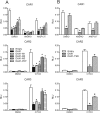The orphan nuclear receptor DAX-1 functions as a potent corepressor of the constitutive androstane receptor (NR1I3)
- PMID: 22896671
- PMCID: PMC3477224
- DOI: 10.1124/mol.112.080721
The orphan nuclear receptor DAX-1 functions as a potent corepressor of the constitutive androstane receptor (NR1I3)
Abstract
Regulation of gene transcription is controlled in part by nuclear receptors that function coordinately with coregulator proteins. The human constitutive androstane receptor (CAR; NR1I3) is expressed primarily in liver and regulates the expression of genes involved in xenobiotic metabolism as well as hormone, energy, and lipid homeostasis. In this report, DAX-1, a nuclear receptor family member with corepressor properties, was identified as a potent CAR regulator. Results of transaction and mutational studies demonstrated that both DAX-1's downstream LXXLL and its PCFQVLP motifs were critical contributors to DAX-1's corepression activities, although two other LXXM/LL motifs located nearer the N terminus had no impact on the CAR functional interaction. Deletion of DAX-1's C-terminal transcription silencing domain restored CAR1 transactivation activity in reporter assays to approximately 90% of control, demonstrating its critical function in mediating the CAR repression activities. Furthermore, results obtained from mammalian two-hybrid experiments assessing various domain configurations of the respective receptors showed that full-length DAX-1 inhibited the CAR-SRC1 interaction by approximately 50%, whereas the same interaction was restored to 90% of control when the DAX-1 transcription silencing domain was deleted. Direct interaction between CAR and DAX-1 was demonstrated with both alpha-screen and coimmunoprecipitation experiments, and this interaction was enhanced in the presence of the CAR activator 6-(4-chlorophenyl)imidazo[2,1-b]thiazole-5-carbaldehyde O-(3,4-dichlorobenzyl)oxime (CITCO). Results obtained in primary human hepatocytes further demonstrated DAX-1 inhibition of CAR-mediated CITCO induction of the CYP2B6 target gene. The results of this investigation identify DAX-1 as a novel and potent CAR corepressor and suggest that DAX-1 functions as a coordinate hepatic regulator of CAR's biological function.
Figures






Similar articles
-
Metformin represses drug-induced expression of CYP2B6 by modulating the constitutive androstane receptor signaling.Mol Pharmacol. 2014 Feb;85(2):249-60. doi: 10.1124/mol.113.089763. Epub 2013 Nov 19. Mol Pharmacol. 2014. PMID: 24252946 Free PMC article.
-
Retinoid X receptor-alpha-dependent transactivation by a naturally occurring structural variant of human constitutive androstane receptor (NR1I3).Mol Pharmacol. 2005 Nov;68(5):1239-53. doi: 10.1124/mol.105.013417. Epub 2005 Aug 11. Mol Pharmacol. 2005. PMID: 16099843 Free PMC article.
-
Switch/sucrose non-fermentable complex interacts with constitutive androstane receptor to regulate drug-metabolizing enzymes and transporters in the liver.Drug Metab Dispos. 2025 Apr;53(4):100057. doi: 10.1016/j.dmd.2025.100057. Epub 2025 Mar 4. Drug Metab Dispos. 2025. PMID: 40158296
-
Transcriptional regulation of cytochrome p450 2B genes by nuclear receptors.Curr Drug Metab. 2003 Dec;4(6):515-25. doi: 10.2174/1389200033489262. Curr Drug Metab. 2003. PMID: 14683479 Review.
-
Clinical Relevance of the Constitutive Androstane Receptor.Drug Metab Dispos. 2022 Jul;50(7):1010-1018. doi: 10.1124/dmd.121.000483. Epub 2022 Mar 2. Drug Metab Dispos. 2022. PMID: 35236665 Free PMC article. Review.
Cited by
-
Regulation of PXR and CAR by protein-protein interaction and signaling crosstalk.Expert Opin Drug Metab Toxicol. 2016 Sep;12(9):997-1010. doi: 10.1080/17425255.2016.1201069. Epub 2016 Jun 23. Expert Opin Drug Metab Toxicol. 2016. PMID: 27295009 Free PMC article. Review.
-
Gene expression profile analysis of Manila clam (Ruditapes philippinarum) hemocytes after a Vibrio alginolyticus challenge using an immune-enriched oligo-microarray.BMC Genomics. 2014 Apr 7;15:267. doi: 10.1186/1471-2164-15-267. BMC Genomics. 2014. PMID: 24708293 Free PMC article.
-
Intronic DNA elements regulate Nrf2 chemical responsiveness of the human microsomal epoxide hydrolase gene (EPHX1) through a far upstream alternative promoter.Biochim Biophys Acta. 2014 Jun;1839(6):493-505. doi: 10.1016/j.bbagrm.2014.03.014. Epub 2014 Apr 2. Biochim Biophys Acta. 2014. PMID: 24704207 Free PMC article.
-
Deciphering the roles of the constitutive androstane receptor in energy metabolism.Acta Pharmacol Sin. 2015 Jan;36(1):62-70. doi: 10.1038/aps.2014.102. Epub 2014 Dec 15. Acta Pharmacol Sin. 2015. PMID: 25500869 Free PMC article. Review.
References
-
- Agoulnik IU, Krause WC, Bingman WE, 3rd, Rahman HT, Amrikachi M, Ayala GE, Weigel NL. (2003) Repressors of androgen and progesterone receptor action. J Biol Chem 278:31136–31148 - PubMed
-
- Altincicek B, Tenbaum SP, Dressel U, Thormeyer D, Renkawitz R, Baniahmad A. (2000) Interaction of the corepressor Alien with DAX-1 is abrogated by mutations of DAX-1 involved in adrenal hypoplasia congenita. J Biol Chem 275:7662–7667 - PubMed
-
- Aranda A, Pascual A. (2001) Nuclear hormone receptors and gene expression. Physiol Rev 81:1269–1304 - PubMed
Publication types
MeSH terms
Substances
Grants and funding
LinkOut - more resources
Full Text Sources
Miscellaneous

